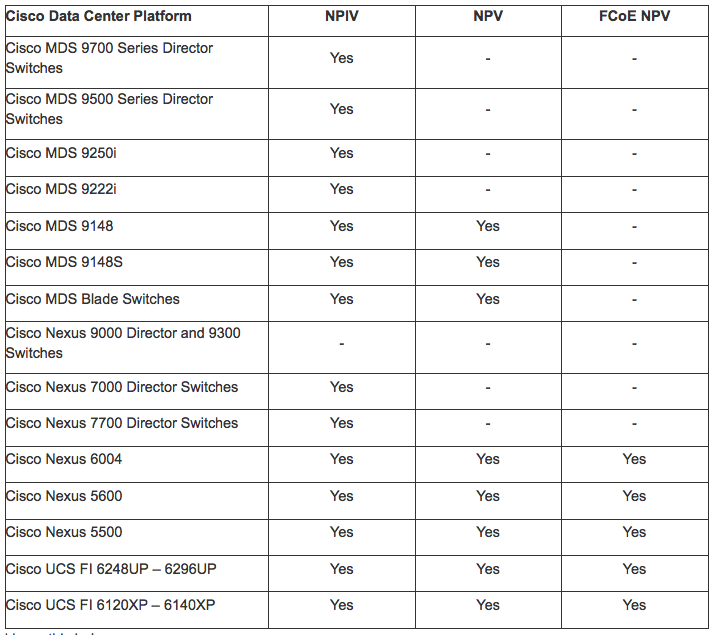Introduction
The purpose of this document is to describe the differences between N-Port Identifier Virtualization (NPIV) and N-Port
Virtualization (NPV) and show their datacenter platform support.
N-Port ID Virtualization (NPIV)
NPIV allows a Fibre Channel host connection or N-Port to be assigned multiple N-Port IDs or Fibre Channel IDs (FCID) over a single link. All FCIDs assigned can now be managed on a Fibre Channel fabric as unique entities on the same physical host. Different applications can be used in conjunction with NPIV. In a virtual machine environment where many host operating systems or applications are running on a physical host, each virtual machine can now be managed independently from zoning, aliasing, and security perspectives.
N-Port Virtualizer (NPV)
An extension to NPIV is the N-Port Virtualizer feature. The N-Port Virtualizer feature allows the blade switch or top-of-rack fabric device to behave as an NPIV-based host bus adapter (HBA) to the core Fibre Channel director. The device aggregates the locally connected host ports or N-Ports into one or more uplinks (pseudo-interswitch links) to the core switches. Whereas NPIV is primarily a host-based solution, NPV is primarily a switch-based technology. It is designed to reduce switch management and overhead in larger Storage Area Network (SAN) deployments. Consider that every Fibre Channel switch in a fabric needs a different domain ID, and that the total number of domain IDs in a fabric is limited. In some cases, this limit can be fairly low depending upon the devices attached to the fabric. The problem, though, is that you often need to add Fibre Channel switches to scale the size of your fabric. There is, therefore, an inherent conflict between trying to reduce the overall number of switches to keep the domain ID count low while also needing to add switches to have a sufficiently high port count. NPV is intended to address this problem.
Cisco Multilayer Data Switch (MDS) 9000 Nexus Operating System (NX-OS) supports industry-standard N-port identifier virtualization (NPIV), which allows multiple N-port fabric logins concurrently on a single physical Fibre Channel link. HBAs that support NPIV can help improve SAN security by enabling configuration of zoning and port security independently for each virtual machine (OS partition) on a host. In addition to being useful for server connections, NPIV is beneficial for connectivity between core and edge SAN switches.
NPV is a complementary feature that reduces the number of Fibre Channel domain IDs in core-edge SANs. Cisco MDS 9000 family fabric switches operating in the NPV mode do not join a fabric; they just pass traffic between core switch links and end devices, which eliminates the domain IDs for these switches. NPIV is used by edge switches in the NPV mode to log in to multiple end devices that share a link to the core switch.

Platform Support
We can summarize NPV and NPIV feature capabilities for Cisco Datacenter platform as below:

